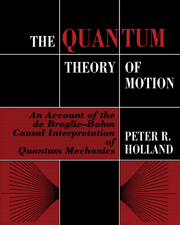 The Quantum Theory of Motion
The Quantum Theory of Motion Book contents
- Frontmatter
- Contents
- Preface
- 1 Quantum mechanics and its interpretation
- 2 Hamilton–Jacobi theory
- 3 Elements of the quantum theory of motion
- 4 Simple applications
- 5 Interference and tunnelling
- 6 The classical limit
- 7 Many-body systems
- 8 Theory of experiments
- 9 Spin ½: the Pauli theory
- 10 Spin ½: the rigid rotator
- 11 The Einstein–Podolsky–Rosen experiment and nonlocality
- 12 Relativistic quantum theory
- References
- Index
5 - Interference and tunnelling
Published online by Cambridge University Press: 20 January 2010
- Frontmatter
- Contents
- Preface
- 1 Quantum mechanics and its interpretation
- 2 Hamilton–Jacobi theory
- 3 Elements of the quantum theory of motion
- 4 Simple applications
- 5 Interference and tunnelling
- 6 The classical limit
- 7 Many-body systems
- 8 Theory of experiments
- 9 Spin ½: the Pauli theory
- 10 Spin ½: the rigid rotator
- 11 The Einstein–Podolsky–Rosen experiment and nonlocality
- 12 Relativistic quantum theory
- References
- Index
Summary
Interference by division of wavefront. The two-slit experiment
Preliminary remarks
In this chapter we shall be concerned with various types of interference effects exhibited by matter waves. It might be argued that all quantum mechanical phenomena are ultimately a consequence of interference, being governed as they are by a linear wave equation. Of particular interest here is the analogue for material waves of Young's double-slit experiment in optics, a classic problem in the history of quantum theory. Feynman, Leighton & Sands (1965) state that it ‘ … has in it the heart of quantum mechanics. In reality, it contains the only mystery’. We shall also treat the process of tunnelling into classically forbidden regions, a phenomenon which also involves interference in an essential way.
To observe the interference of waves issuing from a common source we must split the emerging beam into two spatially separated coherent parts and subsequently recombine them (the superposition of waves from physically independent sources is a many-body problem – see §§8.8 and 12.7). As in optics there are two methods of achieving this: by division of wavefront where, for example, a wave falls on a screen containing two apertures, and by division of amplitude in which a wave is incident on a semi-transparent barrier. Interference effects achieved by the first method, discussed in this section, have been observed for electrons (Jönsson, 1961; Lichte, 1986; Tonomura et al., 1989), neutrons (Zeilinger et al., 1988) and (helium) atoms (Carnal & Mlynek, 1991).
Information
- Type
- Chapter
- Information
- The Quantum Theory of MotionAn Account of the de Broglie-Bohm Causal Interpretation of Quantum Mechanics, pp. 173 - 217Publisher: Cambridge University PressPrint publication year: 1993
Accessibility standard: Unknown
Why this information is here
This section outlines the accessibility features of this content - including support for screen readers, full keyboard navigation and high-contrast display options. This may not be relevant for you.Accessibility Information
- 1
- Cited by